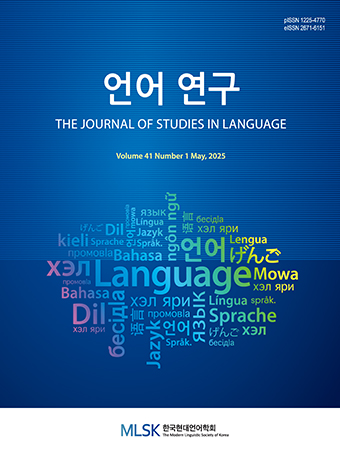Research Article
Abstract
References
Information
It has been assumed that the inalienable possession meaning and the affectedness meaning of the possessor are crucial factors that license external possession constructions (EPCs) in Korean. Previous studies that deal with these conditions semantically or syntactically face theoretical or empirical problems. This paper argues that the acceptability or felicity of EPCs depends on the pragmatic salience of the possessor that establishes an inalienable part-of relation with the possessee in a given context. The pragmatic account is based on the actual EPC examples found in newspapers and blogs, showing that the affectedness condition is not necessary for EPCs. It is proposed that the possessor in an EPC is presented saliently or highlighted by shifting the possessee nominal to a predicate modifier that presupposes the existence of an inalienable possessor.
- Bally, C. 1996. The Expression of Concepts of the Personal Domain and Indivisibility in Indo-European Languages. In H. Chappell and W. McGregor, (eds.), The Grammar of Inalienability: A Typological Perspective on Body Part Terms and the Part-Whole Relation, Berlin: Mouton De Gruyter, 31-61. 10.1515/9783110822137.31
- Barker, C. 1995. Possessive Descriptions. Stanford: CSLI Publications.
- Barker, C. 1998. Partitives, Double Genitives and Anti-uniqueness. Natural Language & Linguistic Theory 16.4, 679-717. 10.1023/A:1005917421076
- Barker, C. 2004. Possessive Weak Definites. In J. Kim, Y. Lander and B. Partee (eds.), Possessives and Beyond: Semantics and Syntax, Amherst, MA: GLSA Publications, 89-113.
- Brisson, C. 1998. Distributivity, Maximality, and Floating Quantifiers. Unpublished Doctoral dissertation, Rutgers University, New Brunswick, N.J.
- Carlson, G. and Sussman, R. S. 2005. Seemingly Indefinite Definites. In S. Kespar and M. Rei (eds.), Linguistic Evidence: Empirical Theoretical, and Computational Perspectives, Berlin: De Gruyter Mouton, 71-85. 10.1515/9783110197549.71
- Chappell, H. and McGregor, W. 1996. The Grammar of Inalienability: A Typological Perspective on Body Part Terms and Part-Whole Relation. Berlin: De Gruyter Mouton. 10.1515/9783110822137
- Cho, S. 1998. A New Analysis of Korean Inalienable Possession Constructions. Proceedings of the North Eastern Linguistic Society 28.1, 79-93.
- Cho, S. 2000. Three Forms of Case Agreement in Korean. Unpublished Doctoral Dissertation, SUNY Stony Brook.
- Heine, B. 1997. Possession: Cognitive Sources, Forces and Grammaticalization. Cambridge: Cambridge University Press. 10.1017/CBO9780511581908 PMC1717055
- Kratzer, A. 1996. Severing the External Argument from its Verb. In J. Rooryck and L. Zaring (eds.) Phrase Structure and the Lexicon. Dordrecht: Kluwer Academic Publishers, 109-137. 10.1007/978-94-015-8617-7_5
- Landau, I. 1999. Possessor Raising and the Structure of VP. Lingua 107.1-2, 1-37. 10.1016/S0024-3841(98)00025-4
- Maling, J. and Kim, S. 1992. Case Assignment in the Inalienable Possession Construction in Korean. Journal of East Asian Linguistics 1, 37-68. 10.1007/BF00129573
- Mithun, M. 1999. The Languages of Native North America. Cambridge, UK: Cambridge University Press.
- Nichols, J. 1992. Linguistic Diversity in Space and Time. Chicago: The University of Chicago Press. 10.7208/chicago/9780226580593.001.0001
- O’Grady, W. 1998. Korean case: A computational approach. Presented at International Circle of Korean Linguistics 11, 1-19.
- O’Grady, W. 2002. Korean case: Extending the computational approach. Korean Linguistics 11, 29-51. 10.1075/kl.11.03wog
- Partee, B. H. and Borschev, V. 2004. Some Puzzles of Predicate Possessives. In B. Partee (ed.), Compositionality in Formal Semantics: Selected Papers, New Jersey: Blackwell Publishing, 292-315. 10.1002/9780470751305.ch15
- Seiler, H. 1983. Possessivity, Subject and Object. Studies in Language 7.1, 89-117. 10.1075/sl.7.1.05sei
- Shin, K. 2007. Partitive Structures. Unpublished Doctoral Dissertation. The University of Illinois at Urbana-Champaign.
- Shin, K. 2008. External possession constructions. Proceedings of the 41st Annual Meeting of the Chicago Linguistic Society 2, 445-456.
- Steedman, M. 2000. The Syntactic Process. Massachusetts: The MIT Press. 10.7551/mitpress/6591.001.0001
- Tomioka, S. and Sim, C. 2005. Event Structure of the Inalienable Possession in Korean. University of Pennsylvania Working Papers in Linguistics 11.1, 279-292.
- Tomioka, S. and Sim, C. 2007. The Event Semantics Root of Inalienable Possession. Manuscript. University of Delaware, Gyeongin National University of Education.
- Yeon, J. 1999. A Cognitive Account of the Constraints on Possessor-Ascension Constructions. Language Research 35.2. 211-230.
- Yeon, J. 2019. A Variety of Grammatical Constructions: Double-Accusative Constructions in Korean Revisited. Hankwuk Ehak 85, 203-241. 10.20405/kl.2019.11.85.203
- Yoon, J. H. 1989. The Grammar of Inalienable Possession Constructions in Korean, Mandarin and French. Harvard Studies in Korean Linguistics 3, 357-365.
- Yoon, J. H. 1990. Theta Theory and the Grammar of Inalienable Possession Constructions. Proceedings of the North Eastern Linguistic Society 20.2, 502-516.
- Yoon, J. H. 2015. Double nominative and double accusative constructions. In B. Lucien and J. Yeon (eds.), The Handbook of Korean Linguistics. West Sussex, UK: Wiley Blackwell, 79-97. 10.1002/9781118371008.ch5 26217387 PMC4513173
- Yoon, J.-M. 1997. The Argument Structure of Relational Nouns and Inalienable Possessor Constructions in Korean. Language Research 33.2, 231-264.
- Publisher :The Modern Linguistic Society of Korea
- Publisher(Ko) :한국현대언어학회
- Journal Title :The Journal of Studies in Language
- Journal Title(Ko) :언어연구
- Volume : 38
- No :1
- Pages :73-88
- DOI :https://doi.org/10.18627/jslg.38.1.202205.73




 The Journal of Studies in Language
The Journal of Studies in Language






